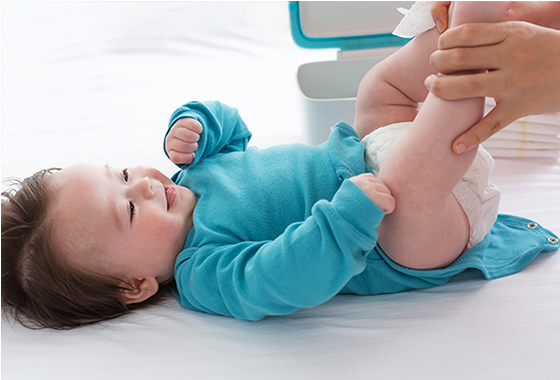
Nappy change time can be a real chore, often happening at the most inconvenient times and usually when you are totally unprepared such as a quick pop into the shops or when you are already running late.
Many of us rush nappy changes as yet another job on the list of things to be done in the day. Some research has found the average nappy change routine to take just under three minutes – which is impressive if you are aiming for the speed record, though the pace doesn’t always allow for opportunities to connect with each other (Laurin, 2017). Nappy changing is a routine that happens frequently throughout the day and can be an opportunity to connect, learn and communicate together (when the timing is right, and you aren’t in full damage control mode!)
Research tells us that when more participation is invited from your child in everyday routines, that there are more opportunities for back-and-forth interactions to occur, supporting learning and creating opportunities for social communication. Routines help children feel safe and secure and are a predictable part of your child’s day (Rogers et a.l, 2012). Routines including nappy change can be an opportunity for teamwork, as your child is invited to cooperate and be part of the experience, though this is easier said than done – especially when things get stinky! If you are struggling with the wiggly worm on the change table that is just trying to get away, maybe turning this into an opportunity for connectedness will support your child’s cooperation.
By age three, your child has likely experienced around 5000 nappy changes (Lally, 2013). Though nappy change is often considered to be health and hygiene focused, it is so much more. They are intimate experiences that can be opportunities to connect, especially since nappy change usually is done in a way that allows for face-to-face connection.
Imagining the nappy change from your baby’s point of view can help you to imagine what they may be thinking, experiencing and feeling. It helps to support your child to be a participant together in the nappy change routine, rather than a participant ‘receiving’ the routine.
Questions you may want to consider from your child’s perspective include:
- What am I liking about getting my nappy changed? What is my favourite/ least favourite part?
- What do I find difficult about nappy change time and what cues do I use to tell you?
- How can my Mum/ Dad/ caregiver help me? What ways can you help me in this moment and routine?
Top tips for nappy changes
- Slow down where possible. We know sometimes you just have to ‘get the job done’, but savour those times where you can take the change routine at baby's pace. This creates more trust and processing time for your baby within the routine.
- Talk to your child during the nappy change experience – let them know what you are doing - all the way from taking clothes off, changing the nappy, and putting clothes back on again. Or what you notice they are interested in.
- You can also use visual cues, for example holding up the nappy or show your child the nappy cream, to let your baby know what is happening next.
- Songs or nursery rhymes associated with nappy change can create a sense of predictability to the routine.
- It’s never too early to introduce the idea of consent. How do you know your child is ready for their nappy to be changed? What cues do they give you that its OK to proceed?
- Nappy change can be fun – but for other children, uncomfortable. Tune in to your child’s feelings by noticing their facial expressions or body movements.
- Respond to your child’s cues – if they are looking up at the nappy you could say ‘you’re ready for your nappy to go on’, or if they are wriggling their legs ‘I can see from your leg wriggle you’re wanting to get back to playing’.
- Offer opportunities for choice and independence where you can. Maybe your child could choose what clothes to put back on. You could hold two options up and whichever one they gaze at for longer may be their choice.
- Enjoy the time of being so close (eye to eye) with your child and if your child likes it, make sure you share lots of kisses and raspberries too.
References:
Laurin, D. E., & Goble, C. B. (July, 2018). Enhancing the diapering routine: Caring, communication, and development. Young Children, 18–24.
Nugent, K. J., Keefer, C. H., Minear, S., Johnson, L. C., & Blanchard, Y. (2007). Understanding newborn behavior & early relationships. Baltimore, MD: Brookes.
Rogers, S., Dawson, G., & Vismara, L. (2012) An Early Start for Your Child with Autism: Using Everyday Activities to Help Kids Connect, Communicate and Learn. The Guilford Press, New York
